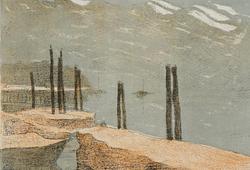John William Waterhouse
"The Rescue"
Signerad J.W. Waterhouse. Utförd omkring 1890. Olja på duk 100 x 67 cm.
Proveniens
Christie's, London, 4 juli 1891; Christie's, London, 12 november 1943, kat nr 66 (?); okänd antikvitetshandel, Göteborg; privat samling, Göteborg (förvärvad från antikvitetshandeln ovan omkring 1960); i arv.
Litteratur
Anthony Hobson, "The Art and Life of J W WATERHOUSE RA 1849-1917", 1980, upptagen i katalogen sid 184 under nr 89 (" 'The Rescue', c 1890 38 x 25 in [97 x 64 cm]" ) samt sid 196 ("Undated Paintings") under nr 298 (" 'The Rescue' 38 x 25 in [97 x 64 cm] ).
Övrig information
Anthony Hobson tar i sin bok om John William Waterhouse (”The Art and Life of J W Waterhouse RA 1849-1917”, 1980) upp föreliggande katalognummer i den avslutande verkförteckningen. Enligt Hobson torde målningen vara utförd "c 1890", vilket stämmer väl överens med Waterhouses dokumenterade samt fotografiskt avbildade produktion från perioden i fråga. Två målningar som det ligger nära tillhands att dra paralleller till är "At Capri" (84 x 74 cm, avbildad helsida i färg, sid 50 i Hobson) samt "Flora" (73 x 33 cm, avbildad sid 53 i Hobson) om vilka Hobson skriver: "The setting of the picture ["At Capri"], including the vine-covered trellis above the figures, associates it with "Flora" (No 80) and appears to confirm one of the series of visits to Italy by the artist begun about 1877" (Hobson, sid 183).
Waterhouse (född i Rom år 1849) hade i början av 1880-talet nått publika framgångar med storslagna historiserande kompositioner som "The Favourites of the Emperor Honorius" (117 x 202 cm, Art Gallery of South Australia, Adelaide) och "Consulting the Oracle" (119 x 198 cm, Tate, London) vilka ställdes ut på Royal Academy år 1883 respektive 1884: "If 'The Favourites of the Emperor Honorius' was a notable success, 'Consulting the Oracle' in the Academy of the following year, 1884, brought J W Waterhouse into the front rank" (Hobson, sid 41). Dessa kompositioner var i stor utsträckning inspirerade av den något äldre konstnären Sir Lawrence Alma-Tadema (1836-1912) vars inflytande på Waterhouse, enligt Hobson, kulminerade i och med 1882 års "Diogenes" (208 x 135 cm, Art Gallery of New South Wales, Sydney). Waterhouse utvecklade sitt historiserande akademiska måleri under slutet av 1880-talet i kompositioner som "Saint Eulalia" (188 x 117,5 cm, Tate, London) och "Marianne" (259 x 180 cm, tidigare i Forbes Magazine Collection) från år 1885 respektive 1887. Den sistnämnda kompositionen skulle komma att markera slutpunkten för Waterhouse som historiemålare när han därefter, år 1888, grep sig an sitt kanske mest berömda motiv "The Lady of Shalott":
"Therefore, although 'Marianne' is a major work in every conventional sense -in its size, in its dramatic quality, in the honours it acquired for the painter- it also signifies another step in self-awareness. With singular good sense Waterhouse retired from history painting at the point of his greatest sucess. The year 1888 brought a change in Waterhouse's approach to his painting with the exhibition of the impressive 'The Lady of Shalott', one of his three major pictures based on Tennyson's poem. [...] Apart from the enormous 'Marianne' of the previous year, 'The Lady of Shalott' of 1888 is the largest picture Waterhouse ever painted. It is a reasonable supposition to regard its size as some measure of its importance to him: the same is evident in 'Diogenes' as well as in 'Marianne', both of which mark the culmination of a period of ideas as 'The Lady of Shalott marks a beginning" (Hobson, sid 49-51).
Den nyorientering Hobson talar om i sammanhanget utgörs av det påtagliga inslaget av friluftsmåleri som bildar bakgrundens foliage i "The Lady of Shalott":
" 'The Lady of Shalott' of 1888 was his first major exercise in landscape painting of this character. Most of his previous subject pictures had been painted in the studio and were of indoor scenes, like 'Marianne', or had an exterior background drawn largely from the imagination" (Hobson, sid 52).
Waterhouse skulle, utifrån sin vistelse på Capri år 1890, under de närmast följande åren utveckla sitt ”plein air” måleri i motiv som den föreliggande ”The Rescue”:
”After the 'Ophelia' of 1889, a visit to Capri provided settings of terrace and garden as in 'Arranging Flowers', 'Flora' and 'At Capri' of 1890. He then began to transfer his attention to the Greek legends in 'Ulysses and the Sirens' of the latter year and the 'Circe' subjects of 1891 and 1892. It was therefore for a period of probably no more than three years that Waterhouse devoted himself wholehartedly to the 'plein-air' painting of interior settings, which combined with the firm use of figures had secured approval for the Newlyn School" (Hobson, sid 52).
Den korta, intensiva utvecklingsfasen med ”plein air” måleri kom emellertid att påverkas i samband med att konstnärens fader William Waterhouse (även han konstnär) avled år 1890: ”How much the passing of his father may have meant to J W Waterhouse as an artist is difficult to say: perhaps little. […] Nevertheless, a perceptible change in his work did occur, and it may be that the death of William Waterhouse aroused deeper and stronger memories than had been evoked by his son’s Italian travels. The ’plein-air’ period came to an end […] and […] there began the notable series of paintings which represent the form of his final creative period. These are pictures in which the setting, however closely dictated by the poet or minutely conjured up through the artist’s imagination, however simple or detailed in execution, is always subordinate to the action and the emotions of the characters portrayed” (Hobson, sid 69).
Framgent skulle Waterhouse arbeta vidare i enlighet med prerafaeliternas läror och ideal.






























































